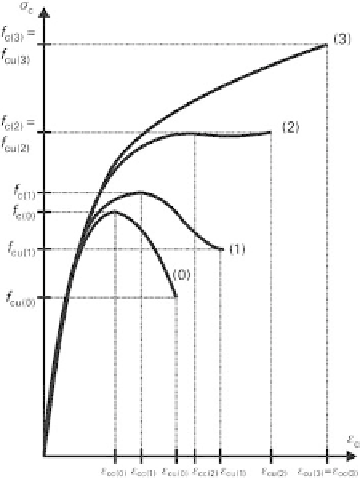Civil Engineering Reference
In-Depth Information
Fig. 7.5
Potential stress
strain curves for compression members con
ned by
fibre-reinforced
materials and carrying axial loads
-
with deformation control, after the strain
ε
cc(1)
associated with the maximum concrete
compressive stress
f
cc(1)
has been exceeded, the stress
-
strain curve descends until the
confining reinforcement fails at strain
ε
cu(1)
, or rather the ultimate strength
f
cu(1)
associated
with that strain. Whereas curve (2) continues approximately horizontally after reaching
the maximum concrete compressive stress
f
cc(2)
, in the case of curve (3) the strain and
stress continue to rise until the confining reinforcement fails. Only in this latter case,
where the stress
strain curve rises strictly monotonically, can we speak of an adequate
con
ning effect with respect to activating the multi-axial strength of the concrete.
Various researchers have proposed criteria to guarantee an adequate con
ning effect.
The experimental studies of
Xiao
and
Wu
[131] led them to propose a stiffness-related
boundary between stress-strain curves rising strictly monotonically and stress-strain
curves with a descending branch. According to [131], the descending branch does not
occur when the following applies:
2
?
t
L
?
E
L
D
?
f
c
-
0
:
2
(7.8)
This approach has been incorporated in the DAfStb guideline.
Based on the work of
Eid
and
Paultre
[132], a simpli
ed stress
strain curve was
speci
ed for design which, as proposed by
Lam
and
Teng
[133], is composed of a
parabolic and a straight part and is continuously differentiable (see Figure 7.6). At the
origin, the slope of the curve is given by the tangent modulus
E
c
of the uncon
ned
concrete. The design approach is de
ned by the following equations:
-


Search WWH ::

Custom Search